He stands in the unbroken line of patriots who have dared to die that freedom may live, and grow, and increase its Blessings. Freedom lives, and through, he lives – in a way that humbles the undertaking of most men.
– President Franklin D. Roosevelt’s memorial citation in WWII
by
Wenxian Zhang
On Sunday, November 16, 1919, to observe the Armistice Day, President George Morgan Ward held a special service in the Knowles Hall. Packed by students and residents from Central Florida, this memorial was to honor former members of the Rollins academic community who had made ultimate sacrifices while serving in the armed forces during the First World War.[1] In the same issue of the student newspaper, a brief announcement also noted that Assistant Secretary of the Navy Franklin D. Roosevelt approved a request that designed Rollins as “the only educational institution in Florida” to which equipment be supplied by the Navy for training purpose on Lake Virginia. This program marked the origin of Tars at Rollins, where “the naval officers in charge of the work of the Rollins Naval Unit mean to give the students helpful and interesting instruction in navigation, seamanship, radio and land-wire telegraphy, military drill, setting-up exercises, and signal work.”[2]

In the 1920 issue of the Tomokan Yearbook, a comprehensive service record documents a total of 159 Rollins alumni who served in WWI. The list includes Berkeley ’07 and Worthington Blackman ’10, President William Blackman’s sons; Alfred Jackson Hanna ’17, future Rollins history professor and vice president of the College; and Raymond Greene ’23, who later served as the mayor of Winter Park and a member of Rollins Board of Trustees.[3] In the sections below, this essay will outline the lives of those Rollins alumni who died while served in military during WWI, WWII, and Vietnam War.
World War I
Among 159 Rollins alumni served in WWI, eight lost their lives: three were killed in actions, three died of illness, one lost at sea, and the other with unknown cause. Born in Rockport, Indiana on March 25, 1899, Charles Mason Stilwell enrolled in Rollins Academy in 1916-17. On April 6, 1917, when the United States declared war on the German Empire, he enlisted in the US Navy six days later. Sadly, on October 4, 1918, Stillwell lost his life on board USS Herman Frasch when it collided with another ship off the Nova Scotia coast.


Due to poor healthcare conditions more than a century ago, three Rollins alumni died of pneumonia while wearing uniform during the WWI era. Born in Ocoee, Florida on May 26, 1897, Claude Sims Brannon ’16 enrolled at Rollins in the 1915-16 academic year. On Feb. 25, 1918, Brannon enlisted in the Army Aviation. He first studied at the Ground School in Princeton and then worked at Carlstrom Field and Banon Field. Unfortunately, he soon caught an infection and without effective treatment, died of pneumonia on December 12, 1918.[4] Paul Walker Harrison ’17 was born in Iowa on September 24, 1898. He moved to Winter Park with his parents in May 1912, attended local public school and graduated from Rollins Academy in 1917. On June 14, 1917, Harrison entered in the West Point Military Academy but died of pneumonia in the Cadet Hospital on March 14, 1918. A Winter Park native, William James Hunter was born on January 12, 1897. He attended Rollins Academy in 1914-16 and enrolled in Business Program during 1916-17. On July 29, 1918, Hunter enlisted in the US Navy but soon died of pneumonia in the Great Lakes Training Camp on September 22, 1918.[5]
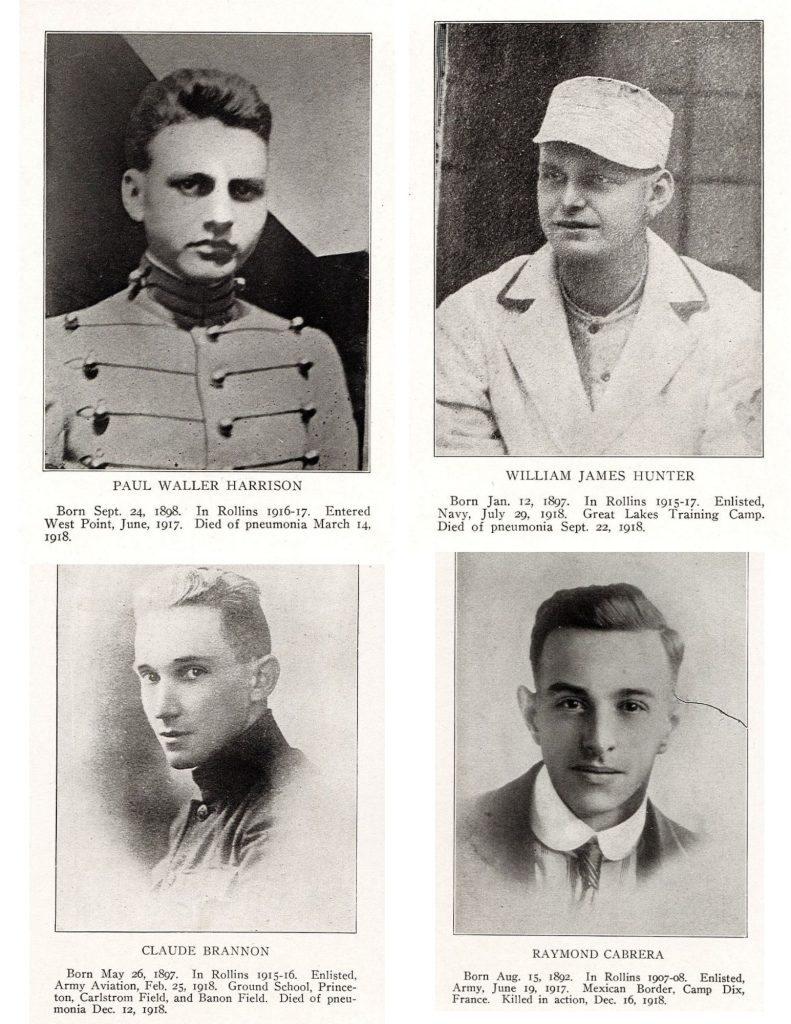
Rollins’ three battlefield casualties all took place in Western Europe, and two of them even after Armistice Day that marked the ceasefire in WWI. Born on August 15, 1892, Raymond Cabrera studied at Rollins during 1907-08. He enlisted in the US Army on June 19, 1917, and was first stationed in Camp Dix, New Jersey. After his unit was shifted to Europe, he was killed in action in France on December 16, 1918. Born in Orlando, Florida on April 20, 1894, Robert Dickinson Lewter ’15 studied at Rollins during 1913-15. He enlisted on April 27, 1918, and after three months of training at Camp Hancock, he was sent to France attached to the 1st Army. On Jan. 22, 1919, Sergeant Lewter was killed by explosion of German mine while performing demolition work on battlefields of France. Unlike other more recent graduates, Thomas Malcolm Saunders was a middle-aged man and the first WWI casualty of the College. Born in Hamilton, Canada on February 28, 1875, Saunders studies at Rollins during 1890-92. A Canadian citizen, he enlisted in the Canadian Army in September 1914 when WWI first broke out. On Aug. 25, 1917, he was killed in action during the Battle of Passchendaele (the Third Battle of Ypres), and the following are the recollections of his army comrade William Fait.

“He enlisted in the Fort Garry Horse and got through four months training in Canada and in England very well, but just when he was under orders to go to France, he got his right knee twisted while riding, which made it impossible for him to ‘carry on’ in a cavalry regiment. They wanted to keep him in home service, but he pleaded with them to send him to France, so he was transferred to the first Canadian Labour Battalion, and we landed in France on the 8th of January 1917. The Battle of the Somme was still going on and we were sent up to the firing line right away… Malcolm proved to everybody that day that he was a good soldier by his coolness and fearlessness, and the way he encouraged those who were not so brave as himself… We had a very cold winter and suffered greatly from the want of proper shelter. Malcolm had his ear and toe frost bitten, but he never complained and carried on, when he really should have been in the hospital… Again at the battle of Tin Court he proved himself a good soldier by his coolness under heavy fire. On the 1st of June we were sent to Belgium and were sent up to the firing line right away to prepare for the great battle of Passchendaele. We were under fire all the time, but the real battle, one of the greatest of the war, was fought on the 31st of July, starting before daybreak, like as if hell was let loose. I can see his face now as it looked to me that morning in the flash of thousands of big guns and star shells and where many men were dying around us, and I can honestly say there was no fear in him. On the 25th of August we were taking measurements on a bridge being built, when a shell bursted a few yards from us and a piece of which hit him in the back, and he died in less than a minute, without saying a word. I am proud that he was my chum, and I am sure there are none who will be so long remembered and praised by those who knew him in France, as Malcom Saunders.” [6]
World War II
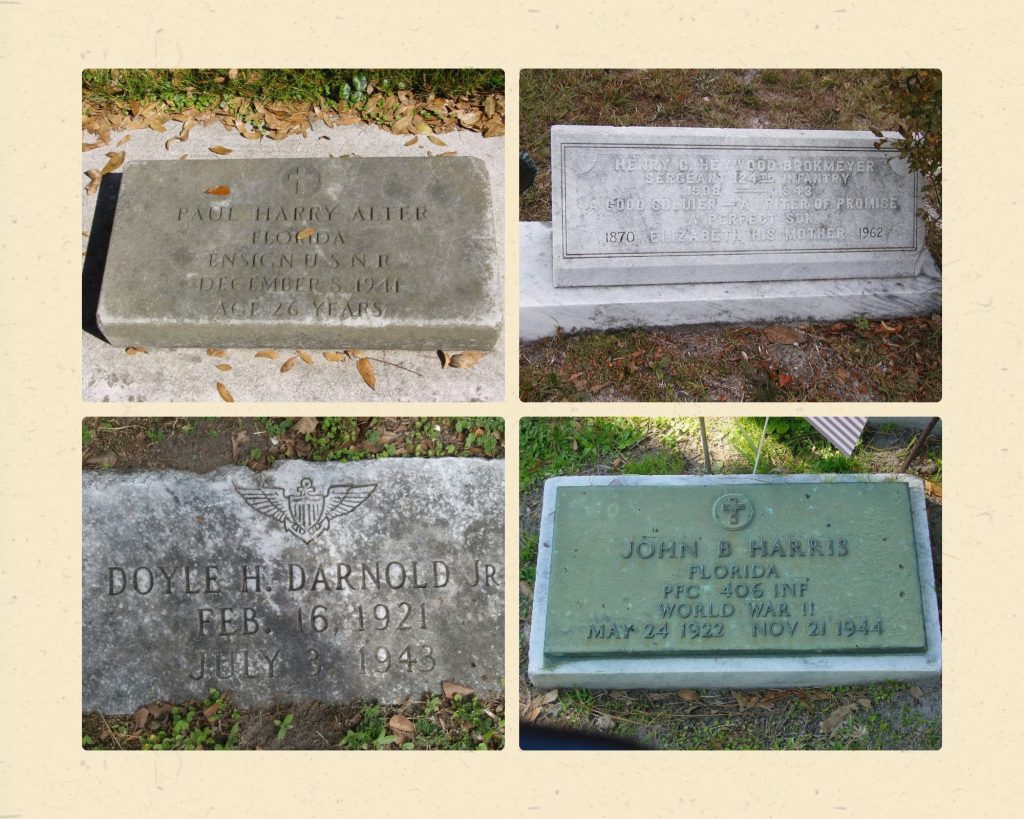
Among hundreds of Rollins alumni went into the United States Armed Forces, twenty-nine lost their lives. Paul Harry Alter ’37 was among Rollins’ first casualties of the WWII era. Born on March 11, 1915, in Fort Plain, New York, Alter moved with his family to 485 Virginia Court in Winter Park and attended Rollins after graduating from Winter Park High School. During 1933-37, he was a member of the varsity swimming team, football squad, and the Theta Kappa Nu fraternity. After teaching high school in Kathleen, Florida for two years, he enlisted in the US Navy on May 15, 1939, and went to Pensacola to become a cadet pilot. On December 9, 1941, on a secret naval patrol mission from Halifax, Nova Scotia, he was killed in a military plane crash off the coast of Newfoundland. For his distinguished services, Ensign Alter received a medal and citation from President Franklin D. Roosevelt and was buried in the Palm Cemetery in Winter Park with full military banners. On December 17, 1941, a memorial service was held in his honor in the Knowles Chapel, where President Hamilton Holt noted that “He was one of the most reliable students on the campus… Paul Alter has lived nobly and died bravely. His maker asked no more of any man.”[7]

Robert Clinton Barber ’34 was born in Ridley Park, PA on February 2, 1913. He attended Rollins during 1930-34, earning his BA in History. He was a member of Kappa Alpha, Interfraternity Council, Key Society, R Club, Pi Gramm Mu, French Club, Intramural Board, Chapel Committee, Studio Club, news editor and business manager of Sandspur. Barber enlisted on March 9, 1943, serving as an ensign in the US Navy Reserve. After completing his basic training at Fort Schuyler, In New York, he also went through the intensive anti-aircraft gunnery program at New Port, RI. First assigned to the Anti-Aircraft Training Center in San Diego, CA, Barber became an instructor and executive officer and earned promotion to lieutenant. On January 6, 1945, he was sent to the South Pacific and finally landed in the Philippines after the Battle of Manila. At the conclusion of WWII, he was hospitalized for nerve fatigue. While on active duty, Lt. Barber caught Rheumatic fever and died in Washington, D.C. on Feb. 3, 1946.[8]

Milton Rusling Beekman ’38 was born in Cranbury, New Jersey on March 31, 1915. After attending New Brunswick High School, he enrolled at Rollins during 1934-36. Beekman joined the Army Air Force in 1936 and was stationed in the Philippines when Japan attacked the Pearl Harbor in December 1941. Beekman was a member of the famed 19th Bomb Group, which was featured in W. L. White’s bestseller Queens Die Proudly in 1943. For his exceptionally meritorious conducts and achievements serving as a B17 pilot with 67 missions in the Pacific Theatre during WWII, Beekman earned the Distinguished Flying Cross Medal, the Bronze Oak Leaf Cluster, and the Legion of Merit Medal from the US Air Forces.[10] On January 11, 1947, on the island of Honshu, Japan, Major Beekman died from a crushing injury while in charge of the Army Air Transport Commend operations for the Pacific region. He received a full military funeral with honor guards from Fort Dix and was buried in Dayton, New Jersey.
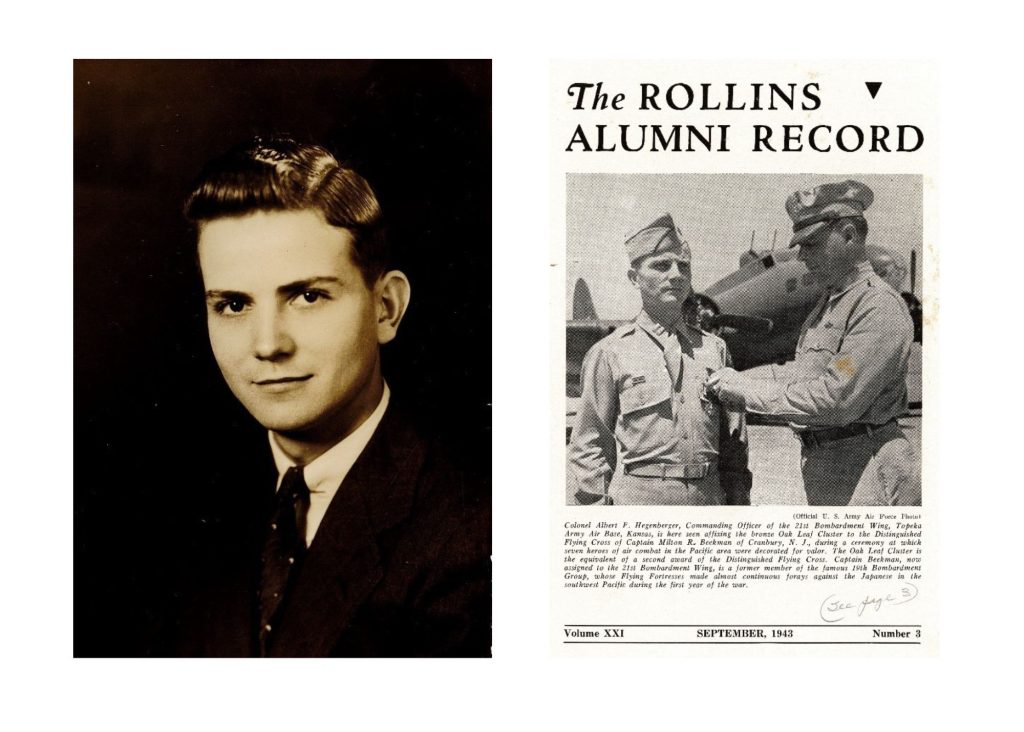
Paul Bouton ’40 was born in Charlottesville, Virginia on August 29, 1916. After attending Lakeland High School, he enrolled at Rollins in 1936 and earned his BA in 1940. He was a member of Lambda Chi Alpha and the crew team and played both football and baseball. Upon graduation, Bouton worked briefly as an assistant coach in Orlando high school before enlisting with the Air Force on November 5, 1941. He went through his air cadet training in the Moody Field in Valdosta, GA and was shifted to England on October 27, 1942. On January 3, 1943, as a B-17 Fortress pilot of the 8th Air Force, he flew one of the seven bombers sent out to destroy a flotilla of German submarines at St. Nazaire, France. Five were shot down before reaching their targets, Lt. Bouton and one other dropped their bombs directly on target but were hit by enemy aircraft. His plane Leapin Liz busted in flames 15,000 feet above St. Brevin before crashing into the Bay of Biscay. His last radio message back to the base: “We are gone but making the target!”[10]
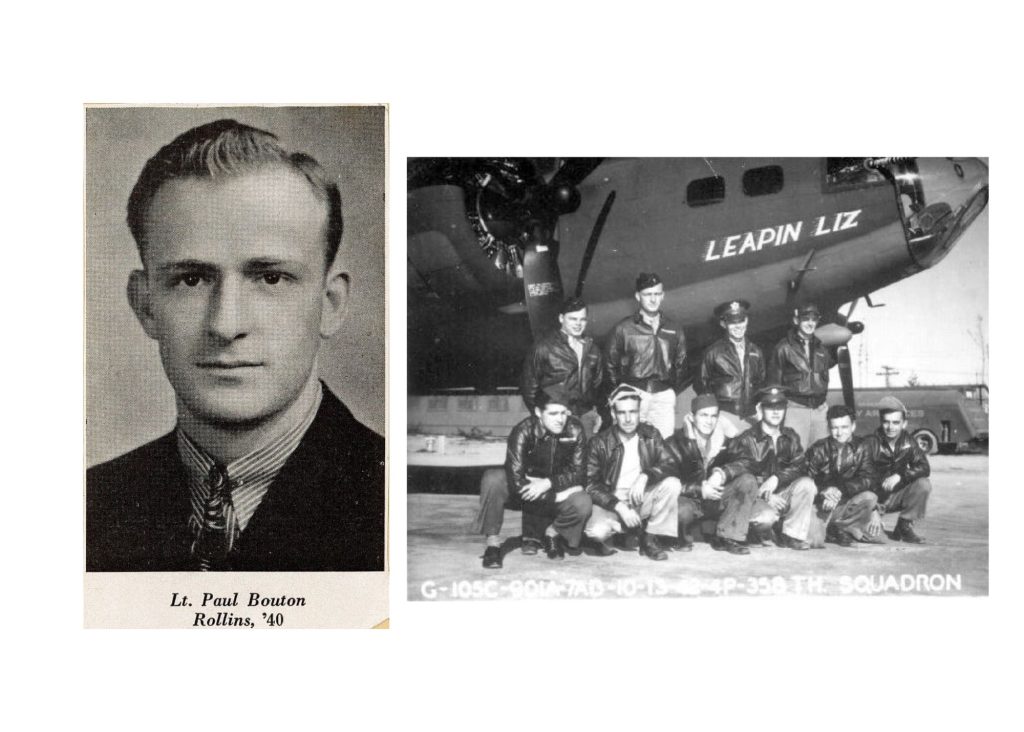
Henry Brokmeyer ’32 was born in Kansas City, MO. on March 24, 1908. He attended the Kansas City Junior College in 1926 but later enrolled at Rollins 1929, earning his BA in English in 1932. Upon graduation, he first worked for Chase & Company in Sandford, Florida, and wrote short stories in his spare time. He was called into the service during WWII, attached to the 24th Infantry of the US Army. In June 1943, while stationing at Fort Benning, GA, at the age of 35 and ready to leave for his overseas duty, Sergeant Brokmeyer died of ulcer on June 16 and was buried in an Enterprise cemetery in Florida. On the tombstone erected by his mother, the inscription reads: “Henry C. Heywood Brokmeyer, Sergeant 124th Infantry, 1908-1943, A Good Solider – A Writer of Promise – A Perfect son.”[11]

Dominick Richard Cerra ’43 was born in New York, NY on November 14, 1919. After attending the Chatsworth School and New Rochelle High School, he enrolled at Rollins during 1939-42 and was a member of the Chapel Choir and Rollins fencing team. However, his study was interrupted with the outbreak of WWII that required more manpower in military services. After completing his primary flight training at Squantum, MA, Cadet Cerra was transferred to the Naval Air Station in Pensacola. While stationing in Florida, he slipped back campus to sing one more time in the tenor section of the Chapel Choir for the 1943 Christmas celebration. Unfortunately, on February 9, 1944, Ensign Cerra was killed in action in an airplane crash from the Melbourne Naval Air Base and was buried with full military honors in the Holy Sepulchre Cemetery in New York.
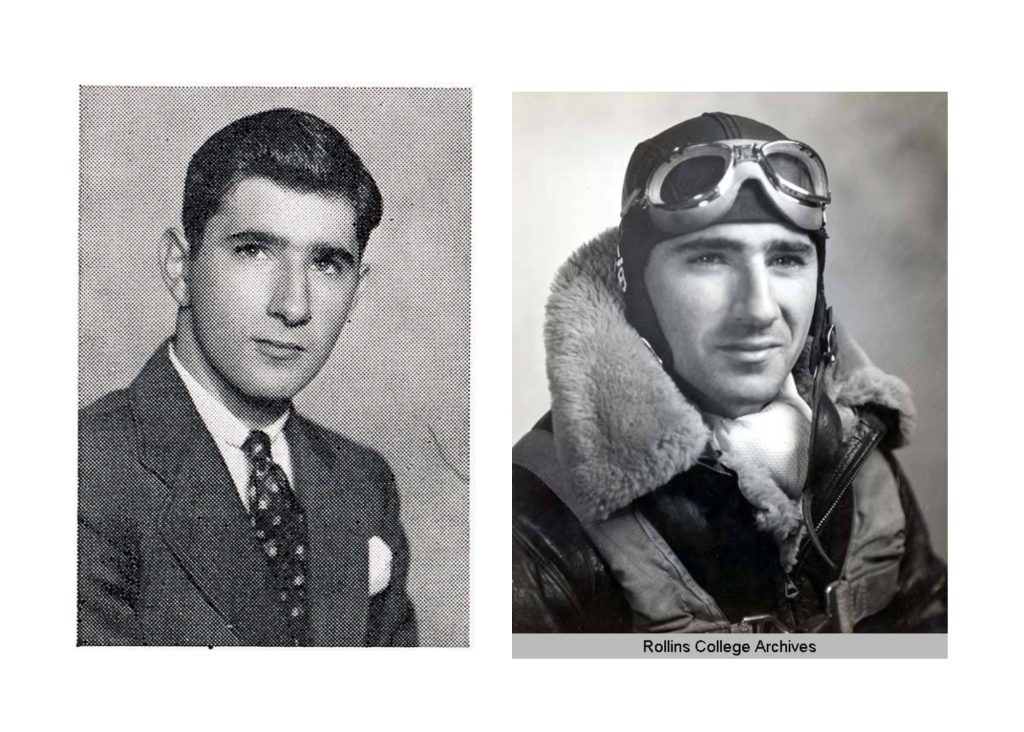
John Gordon Clerk ’32 was born in Peabody, MA on October 2, 1909. After attending the Mitchell Military Academy and Peabody High School, he enrolled at Rollins during 1928-31, and entered the military services when WWII broke out. While serving as a navigator on a C-47 in the US Air Corps, Clerk was killed in a plane crash on taking off in North Africa in 1943. In his memory, his wife established the J. Gordon Clerk Fund for an intramural athletic trophy for male students at Rollins.
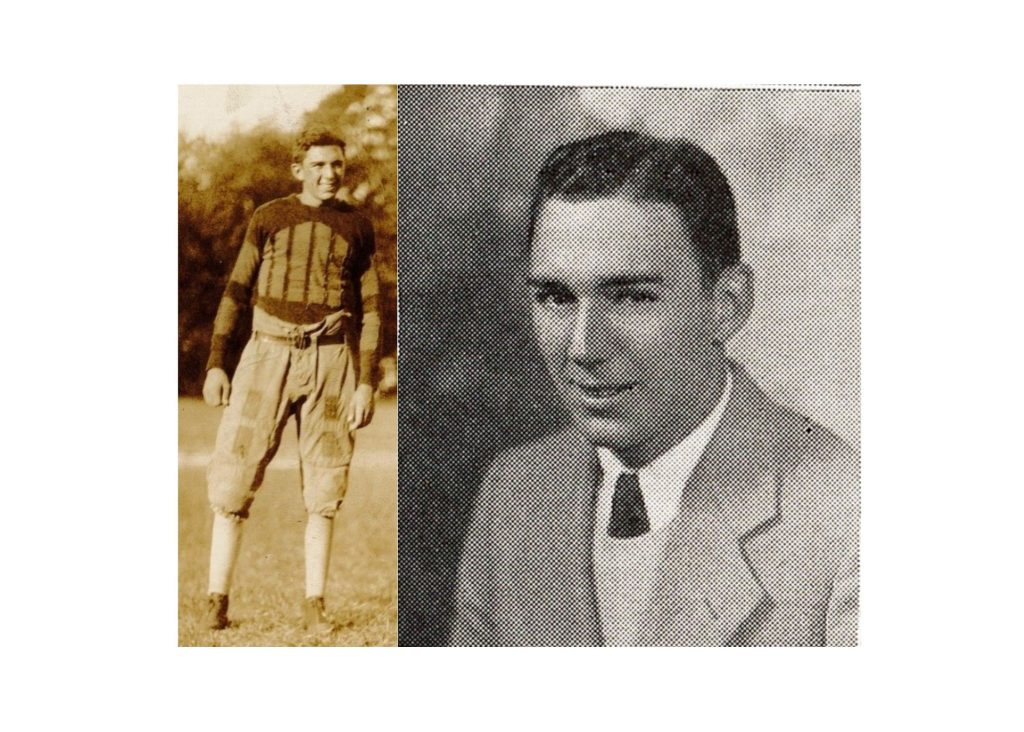
Doyle H. Darnold ’42 was born in Sumner, Miss. on February 16, 1921. At age 10, he moved to Central Florida with his parents and attended the Orland High School. In 1938, Darnold enrolled at Rollins with science major, earning his BS in 1942. He was a member of Lambda Chi Alpha, varsity football, crew, and swimming teams. He also completed his pre-flight training at Rollins and held a civilian pilot’s license before enrolled in the US Navy. On July 4, 1943, Cadet Darnold was killed when his training plane crashed in the Pensacola naval Station.[12] He was buried in Greenwood Cemetery in Orlando with the presentation of honor guards and pall bearers from the Sanford Air Station.[13]

Geoffrey C. Ferris ’41 was born in New Haven, Connecticut on April 8, 1918. After attending Cheshire Academy, he first enrolled at Beloit College before transferring to Rollins in 1939, where he was a member of Sigma Alpha Epsilon, Chapel Choir, and Glee Club. At the outbreak of WWII, Ferris joined the Army, went through basic training at Fort Bragg in North Carolina, and later graduated as 2nd lieutenant from the Officer Candidate School in Fort Sill, Oklahoma. Attached to the 33rd Field Artillery Battalion of the 1st Division, Ferris participated in the landing in North Africa, and received Silver Star for gallantry in action at Kasserine Pass. On May 6, 1943, Ferris was killed while serving as a forward observer giving directions to destroy the German artillery unit in the last Tunisia campaign.[14] For his heroic action, Lieutenant Ferris was posthumously awarded both a Distinguished Service Cross and a Purple Heart medal. He was interred in Tunisia but later moved to the National Cemetery in Farmington, New York.

Samuel Sutherland Gunn ’43 was born in Paris, France on September 28, 1920. He attended Dearborn High School in Michigan before enrolled at Rollins in 1939. While in Winter Park, he also played cello in the Central Florida Symphony Orchestra. However, he was soon put on probation by the Faculty Committee on Student Standing for poor academic performance. After his one-year stay at Rollins, Gunn worked briefly as a toolmaker for Ford Motors before enlisting with the Army on May 25, 1942. He went through pre-flight training at Maxwell Field, Alabama, basin training at Sumter, South Carolina, and advanced training at Valdosta, Georgia before becoming a Flying Fortress pilot at Hendrix Field of the Army Air Force Station. Attached to the 8th Army Air Force Bomber Station in England, his B-17 was among the first daylight bombing of Berlin and other missions at Berman, Munster, Frankfort, and Brunswick. In May 1944, First Lieutenant Gunn was awarded the Distinguished Flying Cross for extraordinary achievement while participating in more than a score of heavy bombing assaults on vital Nazi targets in Germany and occupied Europe.[15] After WWII, Gunn sought to resume his college education but died in Chicago, Illinois on February 28, 1946. He was buried in Oakwoods Cemetery but re-interred in Arlington National Cemetery ten years later.
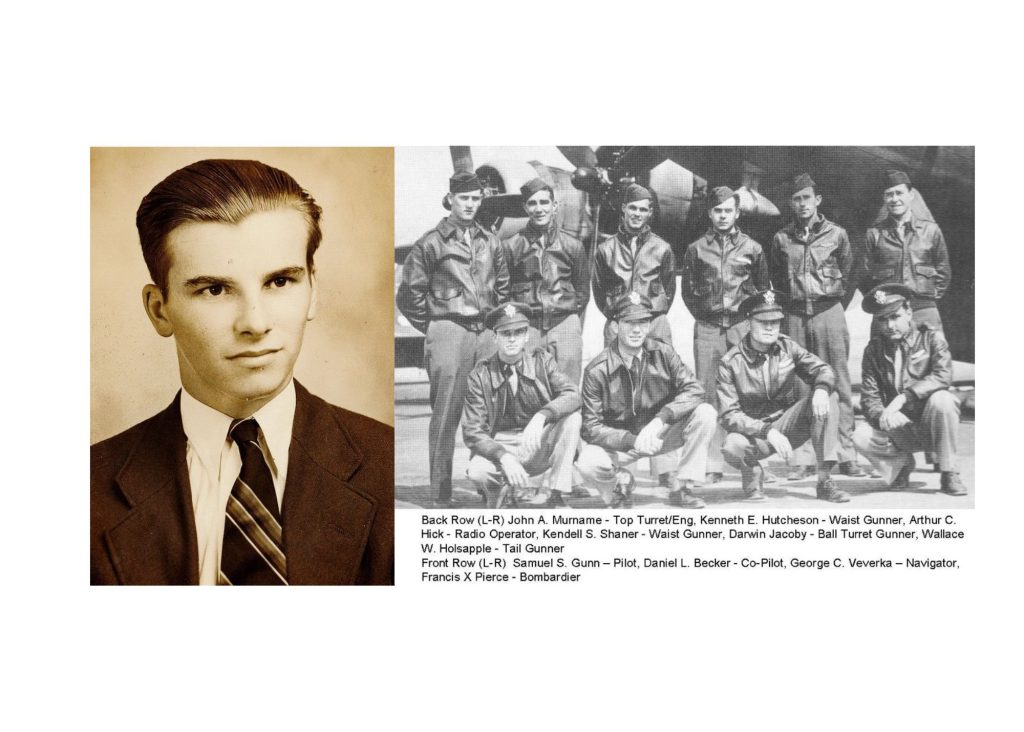
Robert John Haggerty ’41 was born in Warren, Ohio on May 24, 1920. After attending St. James School, he enrolled at Rollins during 1937-40, where both his parents worked in the college dinning services. Haggerty was a member of Sigma Nu and the college football squad. Despite being an all-round athlete, he struggled academically and was put on probation in 1940, which led to his desire for transfer to Michigan State and the US Naval Aviation Cadet training program later. In January 1942, Haggerty enlisted with the Navy, went through his training in New Orleans before being transferred first to Corpus Christi, TX and then Seattle, WA. On April 14, 1943, attached to the 34th Fleet Squadron, Ensign Haggerty died in a plane crash on a dive-bombing mission from a Washington base over Susan Bay and his body was later recovered from Puget Sound.[16] After a rosary service at St. James Catholic Church, he was buried in Woodlawn Memorial Park in Gotha, Florida.
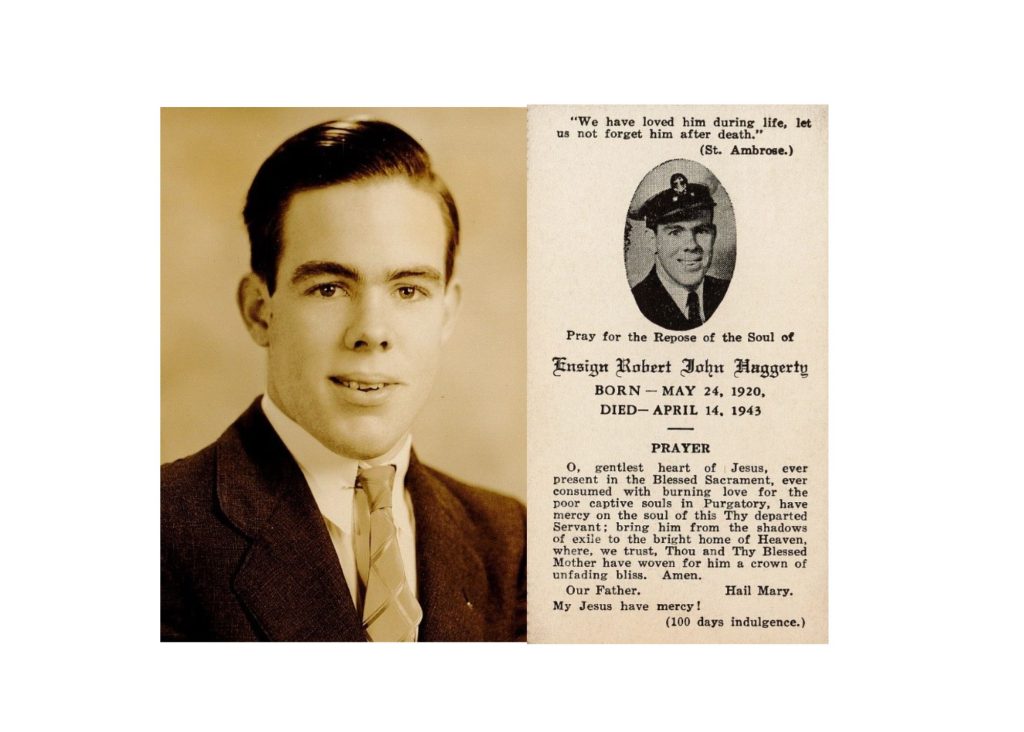
Loren Maxwell Harrington ’38 was born in Bicknell, Indiana on June 7, 1915. A graduate of the Winter Park High School, he enrolled at Rollins 1934, earning his BS in Biology in 1938. He was a member of Rollins Octette, Cappella Choir, Oratorical Association, Interfraternity Council, German Club, Chapel Staff, and charter president of Sigma Nu. Upon graduation, he worked as a graduate assistant in the Rollins Biology Dept. before enlisting in the Army Air Corps in March 1940. After going through his military trainings at Maxwell Field in Alabama and Randolph Field in Texas, on Nov. 15, 1940, he earned his “wings” as a lieutenant from Kelly Field in San Antonio, Texas. While serving on active duty in the Canal Zone, on October 21, 1941, because of the inclement weather, his plane was forced off its course and crashed on Cermeno Peak near Balboa, Panama. In his honor, a special service was held in the Knowles Memorial Chapel on October 25, 1941, with tributes by President Holt, and Rev. Milton Wyatt of the Methodist Church, and singing by the Chapel Choir, of which Second Lieutenant Harrington was a former member.[17]

John Beck Harris ’45 was born in Dan Diego, CA. on May 24, 1922. A leading athlete of Winter Park High School, Harris entered Rollins in 1941, where he was a member of Kappa Alpha, chapel usher, and football team, while holding state records in free style swimming. Like his many classmates at Rollins, his academic life was interrupted by WWII. Drafted by the US Army, he left Rollins on October 30, 1942, first served as a paratrooper but later transferred to the infantry. On November 21, 1944, PFC. Harris was killed in action in Germany, his body was later sent back for a funeral service at the All-Saints Episcopal Church and buried in Palm Cemetery in Winter Park in 1948. Incidentally, his brother-in-law, Capt. T. W. Reed, Jr. ’39 (husband of Rachel Harris ’42), a B-17 pilot, was also killed in action over Germany in 1943.[18]

Robert Louis Howe ’36 was born in Oak Park, IL. on October 2, 1913. After enrolling at Rollins in 1933, Howe earned his BA in History 1936. He was a member of X Club and played football and intramural sports. On January 29, 1937, Howe married his Rollins sweetheart Juliet E. Vale ’36. In a school report, he was described as “bright and intelligent but very irregular in attendance at class and in doing his work – smart enough, however, to get by in spite of this. He improved some in his last year. He was placed on social probation once for going off to Miami without permission. Dean Enyart reports that although he was somewhat dissipated at Rollins and harum-scarum younger, he was a fundamentally good character. He married the Vale girl, who was the same kind as he but Dean Enyart understands that they changed their way of life and settled down into good citizens.”[19] After WWII broke out, Howe enlisted with the US Marine, rising to the rank of captain. On February 27, 1945, he was killed in action in Iwo Jima.[20]

Carl Badger (Bud) Howland, Jr. ’38 was born in Providence, Rhode Island on July 9, 1914. He studied at Trinity College for one year before transferring to Rollins in 1934, first majoring in English, then switching to Music and Languages, earning his BA in 1938. In his application to the Senior Board for graduation, he noted: “In retrospect I feel that I have been broadened, stimulated and awakened by my four years at Rollins. To say that I have been educated would be a falsehood, because true education never ends… As many before me have said, ‘Rollins isn’t a preparation for life, but life itself.’ I feel that I have an excellent foundation for intelligent thought, straight-forward work and successful and worthwhile living.”[21] Through the Institute of International Education, he won a scholarship for graduate work at the University of Vienna in 1938-39, hoping to earn a PhD in German Studies. However, his academic career was cut short by the outbreak of WWII. Serving in the Navy, on August 9, 1942, Howland was reported killed on board USS Quincy during the fierce naval battle of Guadalcanal. According to his shipmate Cox Thompson, Howland was wounded at first but refused medical aid and kept working at his battle station. A few moments later another shell hit Quincy, he fell and in a minute or two went down with the ship as it capsized and sank near Savo Island.[22]

Walter Lee Jordan ’36 was born in Orlando, FL on August 18, 1911. After graduating from Orlando Senior High School in 1929, he first attended Rollins during 1930-32, then transferred to the University of Arizona in 1933, but returned in 1934 and earned his BA in 1936. A member of Kappa Alpha and Rollins crew team, Jordan as an English major spent three and half months on a horseback trip through Mexico in 1934, and an excerpt of his diary was published in the 10:3 issue of Rollins literary magazine Flamingo in 1936.[23] Afterwards, he worked for the Life Magazine in New York briefly and was a member of the Rockefeller Center Camera Club. An aviation enthusiast, Jordon had flown 200 solo hours before entering the service training in October 1941. After earning his wings in 1942, he became a Marine bomber pilot and had two tours of combat duty in the Pacific Theater. On May 2, 1944, on an air raid to the Japanese base in the Solomons Islands, Captain Jordan died in action when his Dauntless dive bomber was hit by enemy fire.[24]
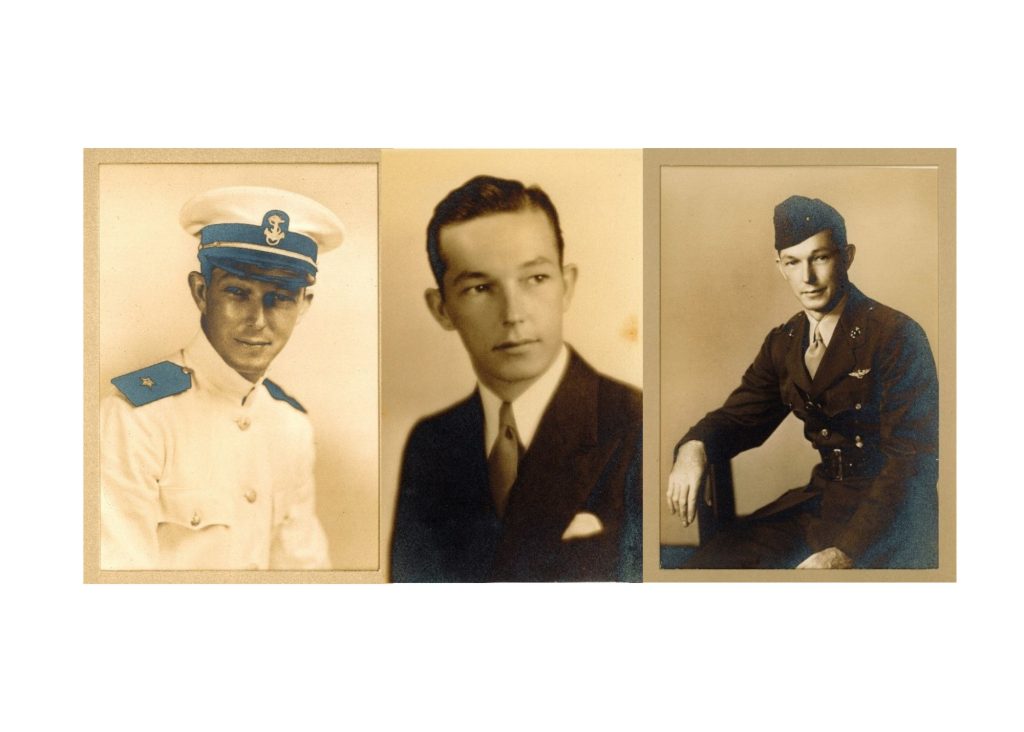
Vernon Howard Langston ’42 was born in Des Moines, New Mexico on August 21, 1920. A 1938 graduate of Orlando Senior High School, he first studied at Clemson College, and then enrolled at Rollins in 1939-40, where he was a member of Kappa Alpha. Afterwards, he worked briefly for the Hubbard Construction Company in Orlando while taking the Civil Aviation Authorities (CAA) courses. On January 24, 1942, Langston entered the US Army aviation cadet program, and later received his silver wings as a pilot in the Air Forces at Napier Field in Dothan, Alabama. On Wednesday, May 26, 1943, Second Lieutenant Langston was killed when his fighter plane crashed in Devon, suburb of Philadelphia, PA. His memorial service was held at the Eiselstein-Wigginton Funeral Home, with pallbearers all lieutenants, a wreath of white lilies from the 357th Fighter Squadron, and riffle solutes.[25]

Clarence William Law ’38 was born in New York, NY on April 29, 1914. He first attended Roxbury Academy and Rensselaer Polytechnic Institute, and in 1935-36 transferred to Rollin, where he won several letters in sports. He worked at New York Edison for several years before enlisting with the US Army in December 1940. Lieutenant Law first served as a regimental transportation officer for overseas operations, and then a liaison between the infantry and the headquarters for the conference of General MacArthur and Admiral Nimitz. After his promotion to a captain in the Army, he led a company of infantry in the amphibious assaults on Kwajalein and Eniwetok atolls. On April 20, 1945, Law was killed in action in the battle of Okinawa.[26] In 1997, for the dedication of the Peace Monument in Japan, President Rita Bornstein visited the Peace Park and laid flowers to the Battle of Okinawa Memorial that contains Captain Law’s name.[27]

Edward deHart Lott ’44 was born in Miami, FL on April 1, 1920. He attended the James Madison High School (1936-38) in Brooklyn and the Irving School (1938-40) in Tarrytown, New York before enrolling at Rollins in 1940-41, where he was a member of Sigma Phi Omega and played golf for Rollins. On April 8, 1942, Lott married Louise Caroline Elliott ’43 in the Knowles Memorial Chapel; three months later, he was called into service. Attached to 378th Infantry in General Patton’s 3d Army, on November 12, 1944, PFC. Lott was killed in action near Thiensville, France. He was survived by his wife and one-year old daughter Suzanne Louise.
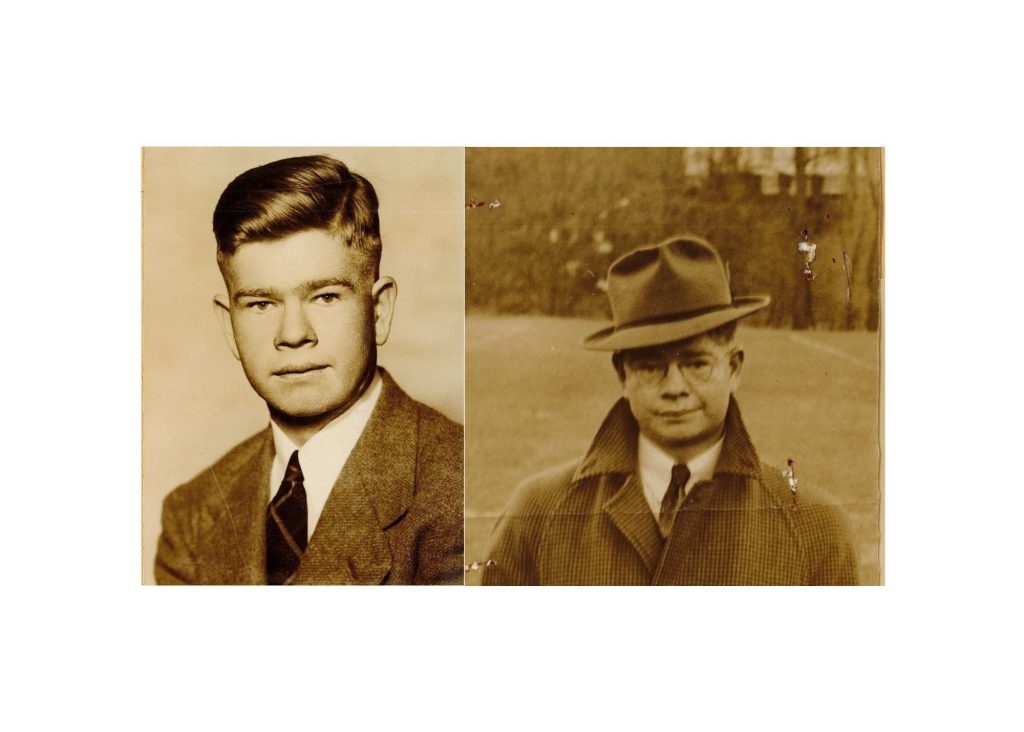
Welborn G. McMurray, ’02 was born in Maitland, Florida on November 28, 1886. He attended Rollins Academy during 1897-1902, and then enrolled at the University of Chattanooga, where he earned his law degree in 1909. McMurray worked briefly as an attorney in Tennessee before becoming an officer in the Philippines Constabulary, stationed in Manila in 1911-16 under General John J. Pershing. During the WWI years in 1917-19, he was a lieutenant in the Finance Dept. of the US Army in Washington, DC. Before his discharge, he married Harriett Mann Hawes on January 30, 1919, and their son Henry Sanford was born on July 14, 1921. At the outbreak of WWII, McMurray returned to active duty with the rank of major in August 1941 and was immediately assigned to the Army Air Corps in the Philippines. On March 30, 1942, he sent his last cable to his wife from Cebu Island and then went missing during the intense Battle of Bataan. It was years later that his death was confirmed in the Cabanatuan Prison Camp on June 14, 1942.[28] Buried in Manila, Philippines at age 56, he not only served in the two world wars, but also was the most senior member of Rollins alumni on record who died in armed conflicts of the 20th century. Incidentally, while Lieutenant Colonel McMurray was missing in action, his son Captain Henry McMurray served as a B-17 bomber pilot and completed 25 raids over Germany during WWII.[29]

Albert Phillip Nassi ’43 was born in Worcester, MA on October 26, 1919. After attending Orleans High School (1933-37) in MA, he studied at the New England Conservatory of Music (1937-38) and Boston University (1938-40) before transferring to Rollins in 1940. A brilliant violin student, he once studied under Walter Trumpler, was a member of the Delius Chamber Music, and frequently played as soloist and with ensembles in Winter Park and the Central Florida Symphony Orchestra. Nonetheless, his promising music career was cut short by WWII. In spring 1943, Nassi left Rollins to join the armed forces. As a staff sergeant in the Air Corps, he served as a radioman and waist gunner on a bomber in the European Theater of war. In July 1944, Sgt. Nassi, the only son of Thomas and Olympia Nassi of Orleans, MA, was killed in action in Europe.[30]

Leonard Franklin Phillips ’42 was born in Deer Lodge, TN on June 30, 1916. After attending Leesburg High School (1933-36) in Florida, he studied at Green Mountain Junior College (1936-37) before entering Rollins in 1937, where he was a star of the football team. After one year of absence, he returned to Rollins during 1939-41, became a member of Phi Mu, and appeared among the cast of the Music Master play at Annie Russell Theatre. In 1940, he married Betty Anne Bundeson of Chicago, IL, who attended Rollins during 1940-41. On November 18, 1944, while Betty was expecting, Sgt. Phillips was killed in action in France.[31]

Theodore Worcester Reed, Jr. ’39 was born in Newton, MA on January 31, 1916. He enrolled at Rollins in 1935 and earned his BA in French in 1939. He was a member of Kappa Alpha, Athletic Key, and French and Spanish Clubs while earning several letters in crew and swimming. Upon graduation, he worked for Liberty Mutual in New York as an insurance claim adjuster before enlisting on January 1, 1942. In October 1942, he married Rachel Harris ’42, Rollins swimming star and daughter of John Harris of Winter Park. After going through military training and becoming a pilot of a Flying Fortress, on April 1, 1943, Reed was sent to England as a flight commander in the 8th Air Force, eventually earning his Air Medal with two clusters and the Purple Heart. His first plane Vox Pop I was lost in the North Sea, Vox Pop II was badly damaged on September 12 in a raid over Germany. On October 4, 1943, Reed flew his 15th flight in a raid on Frankfurt. His Vox Pop III was shot down, Capt. Reed was missing in action while five members of the ten-man crew became prisoners of Germany.[32]

Abbott Rogers ’42 was born in Orlando, FL on February 23, 1920. After attending Westtown School (1935-38) in PA, he enrolled at Rollins 1938-39. Upon the death of his father, he withdrew from Rollins and began to work for Abbotts Dairies in Philadelphia, a company founded by his grandfather George Abbott, whose winter home was in Orlando. He entered the US Army after the outbreak of WWII, and was commissioned a second lieutenant at the Infantry School in Fort Benning, GA. On May 15, 1943, while stationed at Camp Croft in South Carolina, he married Elaine Sheble of New Jersey. During the Battle of Bulge, on December 17, 1944, First Lieutenant Rogers was killed in action. His name was added to Rollins Roll of Honor and a Gold Star Scholarship was established in his memory.
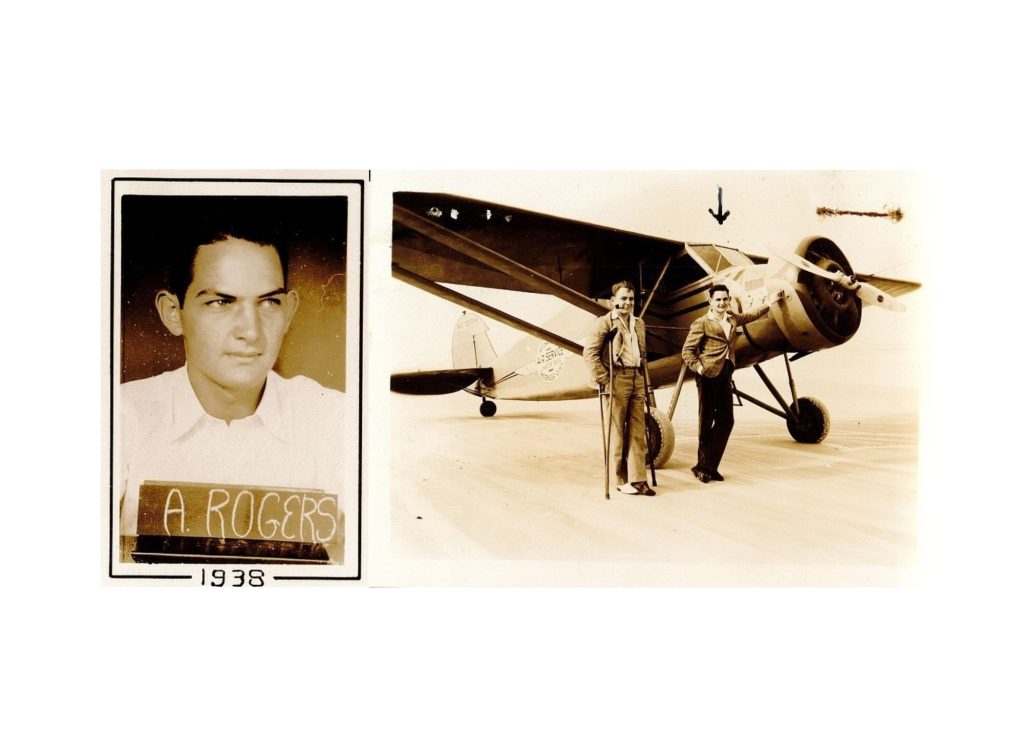
Colfax Sanderson, Jr. ’31 was born in Topeka, Kansas on July 27, 1909. After graduating from Orlando High School, he enrolled at Rollins in 1927-30, where he also worked as an assistant in Dramatic Art and helped with play As You Like It at the Annie Russell Theatre. In New York City on September 28, 1940, he married Ruth Goodman of Los Angeles. However, his family life was soon interrupted by WWII. On June 18, 1945, while serving with the US Army Medical Corps as a T-5 technician attached to the 162nd Infantry of the 41st Division in the Philippines, Sanderson died of malaria in the Pacific. In his letter to Mrs. Sanderson, Army Chaplain James R. Kreesling wrote: “During the campaign at Davao in Mindanao, our men were frequently wet for days at a time, living in fox holes, sleeping and eating in them, many took sick and had to be tended to, your husband was tireless in his efforts in bring help to those who were sick or wounded. From exhaustion, he fell ill from pneumonia. He gave his life in action for his fellowmen. Surely a hero in the sight of his fellow soldiers and of his God.”[33]

Gordon Lowell Spence ’37 was born in New York, NY on May 19, 1914. Upon graduation from the Choate School in Wallingford, Connecticut, he studied at Rollins during 1933-35, where he was a member of Kappa Alpha, Chapel Committee, French Club, Fox Society, Publications Union, and proof editor of Sandspur. In October 1935, he married Dulany Smith of Baltimore in New York, their daughter Holly Dulany was born in November 1936, both his wedding and daughter’s birth were reported in the New York Times. Unfortunately, the looming global war had negatively impacted his seemingly promising life. On September 16, 1941, while serving in military, Spence was killed in a tragic automobile accident at Fort Ord, CA.
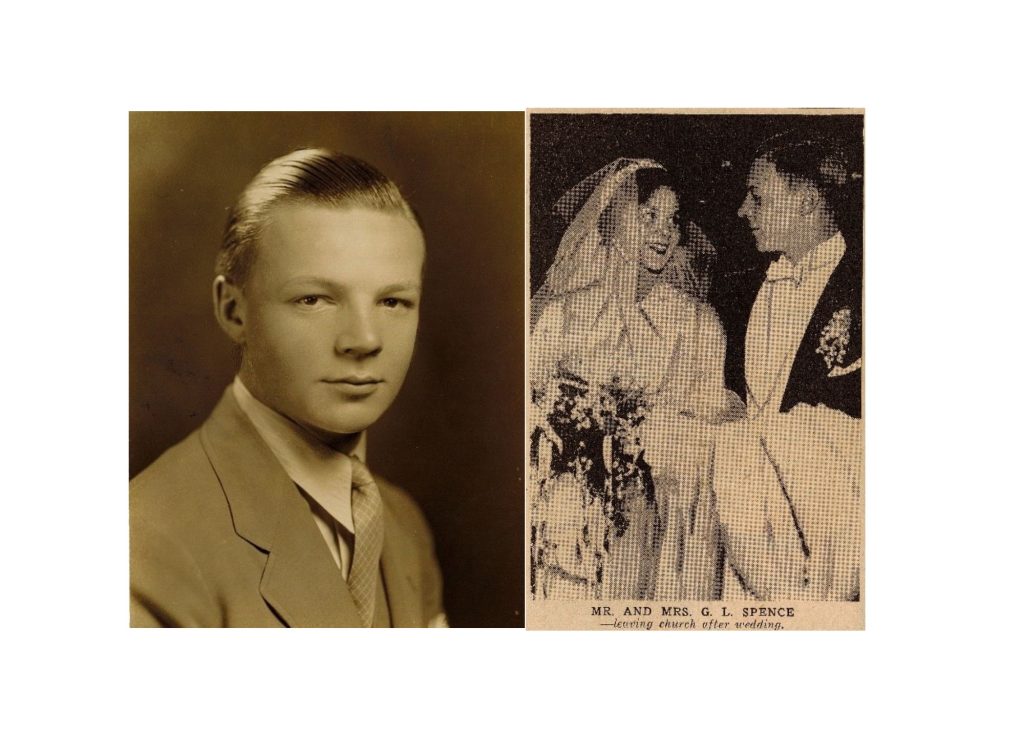
Robert Louis Stevenson ’34 was born in Richwood, Ohio on May 17, 1912. He first attended Georgia Military Academy and Orlando High School before entering Rollins in 1929 and earning his BA 1934. At Rollins, he was a member of Kappa Alpha, Sandspur, baseball, and debate teams. Afterwards, he worked for Babcock Aircraft Corp as an inspector, and married Hannah Redman Dean of Orlando on July 7, 1936. In 1942, Stevenson enlisted with the US Air Corps and lived through the early air battles in the European Theater. On January 11, 1944, Sgt. Stevenson was killed on a bombing mission in Germany.[34] He was buried in a Dutch cemetery, and his grave was reported adopted by Miss Emile Roosenboom of Heerlerbaan, Holland.[35]

Frederick Herrick Timson, Jr. ’29 was born on July 20, 1906, who attended schools in Swampscott and Sharon, MA, and then enrolled at Norwich University in Vermont before transferring to Rollins in 1925-26, where he was a four-letter man in athletics. Afterwards, he became a trainee and later assistant manager of the W. T. Grant Store in Orlando. Volunteered for service in February 1941, Timson trained at Savannah, GA with the 35th Bomber Command and arrived in the Philippines in December 1941, four days before Manila was attacked by the Japanese forces. After receiving one letter from him dated Feb. 11, 1942, his mother Mrs. Weeks Timson of 225 Holt Ave. was notified by the War Department two years later that PFC. Timson was officially declared dead after missing in action at the fall of Bataan and Corregidor on May 7, 1942.[36]
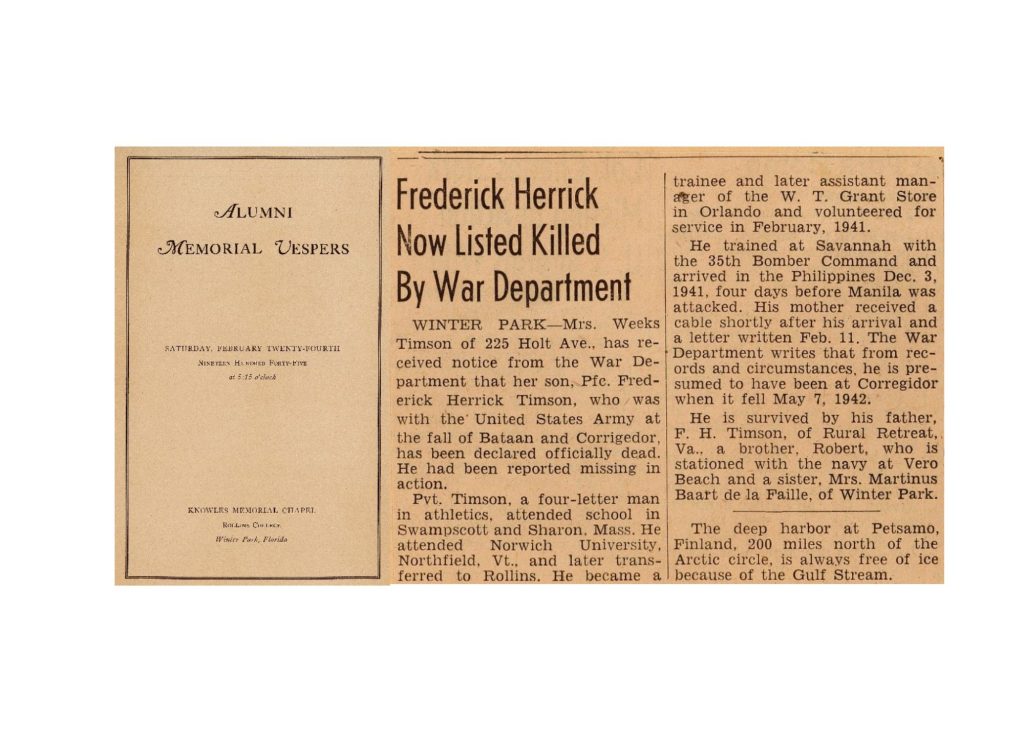
John Eaton Wagner ’42 was born in Knoxville, TN on February 20, 1919. He was a member of the Winter Park Chapter Order of DeMolay and graduated from Winter Park High School in 1937. After attending the University of Cincinnati for one year, he transferred to Rollins 1938. Staying till 1940, he became the first trainee in Rollins’ Civilian Pilot Training Program to fly solo. In 1941, Wagner became an aviation cadet at the US Naval Air Station in Pensacola and later completed his training at the Naval Reservation Aviation Base in Miami, FL. Attached to Squadron 42, on July 22, 1942, Lieutenant Wager was killed in a plane crash while on a scout mission in the Atlantic. In grateful memory of John Eaton Wagner who died in the service of his country, President Franklin D. Roosevelt noted in his citation: “He stands in the unbroken line of patriots who have dared to die that freedom may live, and grow, and increase its Blessings. Freedom lives, and through, he lives – in a way that humbles the undertaking of most men.”[37]

Vietnam War
During the Korean War in the early 1950s, although some alumni served in the armed forces, no archival records are available on the death of former members of the Rollins academic community. However, this is not the case during the Vietnamese conflict, when four Rollins men lost their lives in the 1960s and 1970s.
McCrea Benedict Tuttle ’65 was born in Cincinnati, Ohio on June 20, 1943. He enrolled at Rollins in 1961, earning his BA in Business Administration four years later. While studying at Rollins, he enlisted with the US Marine Corps and became one of the two men graduated in uniform in 1965. In addition to his activities in intramural football, soccer, baseball, and volleyball, he was a chapel usher and a member of the French Club, and served as the treasurer, secretary and vice president of Lambda Chi Alpha.[38] Upon graduation, Mac became a commissioned officer in the US Marine Corps; and after basic training in Quantico, Virginia, he was sent to Vietnam in April 1967. On Saturday, March 9, 1968, as a member in the Combined Action Groups of the Third Amphibious Force, Capt. Tuttle was killed by an explosive device in Da Nang, South Vietnam.[39] In his memory, a Book-A-Year fund was established by Chapel Dean Donald W. Hill, President and Mrs. Hugh McKean also gave a Book-A-Year Memorial for Marine Captain Tuttle, first Rollins graduate killed in combat in Vietnam.[40]
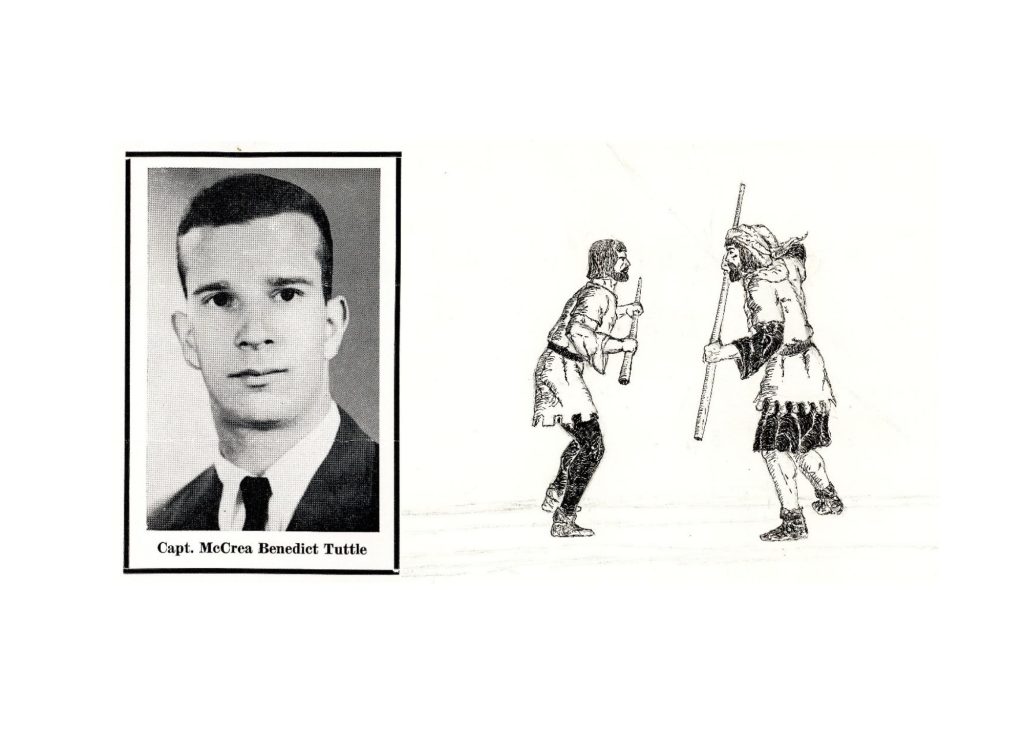
Dustin (Dusty) Cowles Trowbridge ’66 was born in Saint Charles, Illinois on January 13, 1944. He enrolled at Rollins in 1962, was a member of Tau Kappa Epsilon and Rollins Scientific Society and earned his BA in Psychology 1966. With the US military engagement in Asia, Dusty became a Navy navigator in Vietnam and started a tour of duty in August 1969 on board Carrier USS Coral Sea. On December 26, 1969, after having successfully refueling, his military plane lost power and started to lose altitude. Both Dusty and his navigator ejected but his parachute failed. Lieutenant Trowbridge’s body was never found in the Pacific Ocean.[41] Considered him buried at sea, the Navy held a memorial service at its naval base in Norfolk, Virginia. At Rollins, in his memory a Book-A-Year fund was established by his classmates.
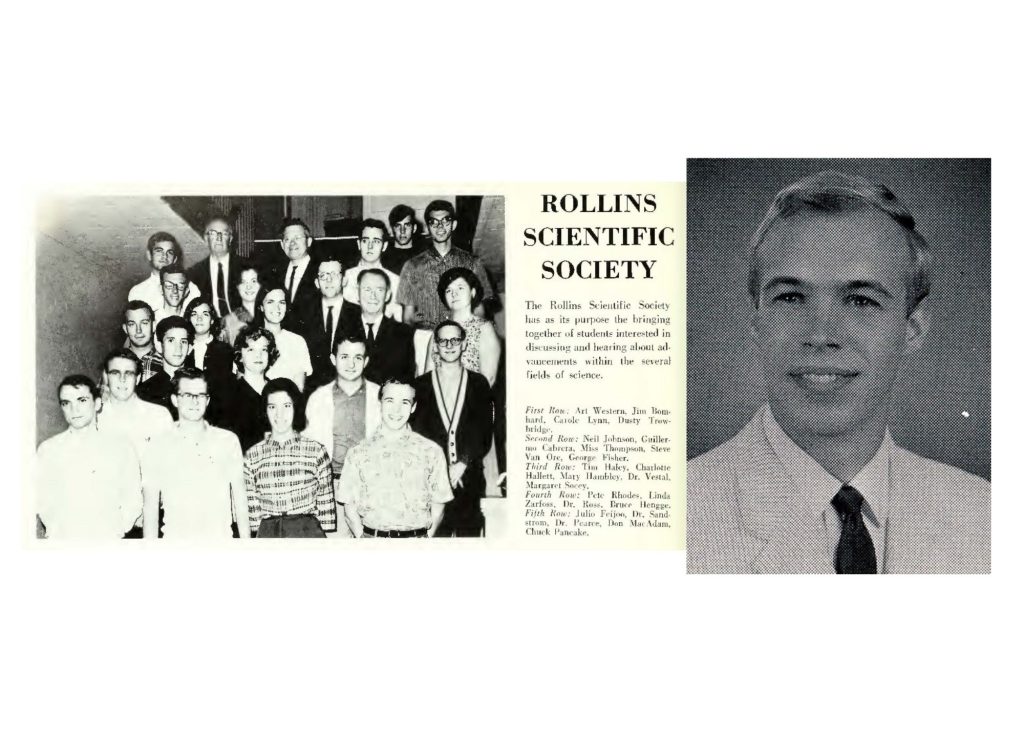
Charles Clark Willard II ’64 was born in Schenectady, New York on August 29, 1941. A graduate of Winter Park High School, he first attended the University of the South before transferring to Rollins and graduated with a BA in Business Administration in 1964. Willard was an active student leader on campus, serving on the Judicial and Executive Councils. As Pledge Class Vice President, he was on the Dean’s List, a member of Sandspur, Orientation Committee, Fiesta Float Committee, and Sigma Nu, in addition to his multiple athletic activities, such as playing intramural football, volleyball, and basketball, and working as a varsity baseball manager.[42] After graduating from Rollins, Ensign Willard served as an Assistant Harbor Control Officer in the US Navy and died in Subic Bay in the Philippines on June 27, 1966.

Charles H. Kitchell ’70 was born in Larchmont, New York on May 20, 1948. He enrolled at Rollins in 1966, earning his BA in Theater Arts in 1970. Another active student leader on campus, Kitchell was on both the Dean’s and President’s Lists, a recipient of the Algernon Sidney Sullivan Award, Thomas R. Baker Chemistry Award, and Oslo Scholarship. He was also a member of the Phi Society, Tau Kappa Epsilon, Student Council, New Hall Council, dean’s staff, chapel usher, student court investigator, student representative on Scholarship Committee, in addition to playing varsity soccer, paddleball, track, and serving as treasurer and president of the X Club.[43] Upon graduation, Kitchell became an aircraft commander at the Mountain Home Air Force Base in Idaho, and earned his Distinguished Flying Cross Medal for air operations over Southeast Asia in 1973. Captain Kitchell died on March 29, 1978, while stationing in England. In 1980, his family established a scholarship award at Rollins “to be granted to a senior member of the soccer team for outstanding achievement and exemplary sportsmanship.”[44]

Rollins Veterans Memorial
It is often said that college years are probably some of the best phases of people’s lives when they can explore, learn, make friends, and grow up, and this has been the case for many Rollins alumni throughout most of the institutional history since its founding in 1885. However, during the moments of crises, especially when the fate of the democracy is at stake, numerous Rollins men and women have answered the call of their country and bravely stepped forward to serve in the U.S. military. Many of them interrupted their academic study to enlist in various armed services. From the historical photograph collections kept in the College Archives, a group gathering of the Young Men’s Christian Association of 1914 – 1915 at Rollins sheds some lights on student life on campus more than a century ago. Among a group of 26 people, at least 11 people went into services in the ensuing years, and one person perished while wearing uniform during the “Great War.”
Rollins WWI veterans pictured here include in the front row: Walter Ray Martin (American Expeditionary Forces), first from left; Robert Hutchinson (US Navy) second from left; Raymond Greene (US Navy) third from left; John Sherwood Foley (US Naval Reserve Force) center; Albert Randolph Lake (US Army Aviation) second from right. On back row: Berkeley Blackman (Army Aviation), eighth from left; Edwin McQuarters (Med. Dept.), fifth from right; A. J. Hanna (USNRF), second from right; and Henry Fordham (US Navy), first in the back row. William Hunter (US Navy) was second from left on the back row standing next to Dean Arthur Enyart, who later also served in the military in France.
When WWII broke out in 1941, Rollins went into swift action for war preparations. According to the College Catalogue in the early 1940s: “The present world conflict has taught us that democracy can survive only if we utilize to the utmost the talents of each individual. Thus we believe that sound individualization in education is the most effective way to lead our students into paths that will fortify them, as loyal exponents of democratic ideas, to withstand the shocks of these days and prepare them to create a permanent peace resting on the foundation of true democracy.”[45] Rollins was one of the first institutions in the country to sponsor the federal CAA program that sought to train collegians in the art of flying, which later led to many students serving in the US Air Forces.[46] The campus also hosted the STAR (Specialized Training & Reassignment) Unit of selected soldiers for advanced technical training in Pinehurst. More strikingly, the gender ratio of the student population changed drastically in the early 1940s. In the 1941-42 academic year, at the outbreak of WWII, there were still 206 male students out of the total enrollment of 430 (47.9% vs. 52.1%); two years later, as more men went into military services, only 49 males remained at Rollins out of 299 students (16.4% to 83.6%).[47]

Besides those aforementioned alumni who died for their country in uniforms, many Rollins graduates were also wounded during brutal combats, and some were even captured by enemy forces, among them Lt. Merlin Mitchell ’42 and Lt. John Glendinning ’45, both German prisoners of war in Europe.[48] After the victory of WWII, and with the financial support of the GI Bill, many former students were finally able to return campus and assume their study at Rollins. In 1945-1946, veterans were very much a part of campus life in Winter Park: one hundred twenty-two of the 534 students enrolled at Rollins were ex-servicemen, making them almost 25 percent of the student population.[49]
On March 24, 2000, during the Alumni Reunion Weekend, Rollins held a veterans memorial service in the Knowles Memorial Chapel and a dedication ceremony that included the presentation of the Honor Guard, National Anthem, remarks, remembrance, and military taps. The current Veterans Memorial was given to the College by Rollins veteran William F. Koch, Jr. ’49 and his wife, Mary Lou Koch ’48. Located next to the Warren Administration Building directly facing the Knowles Memorial Chapel, the solemn monument bears the inscription “In grateful remembrance of Rollins alumni who gave their lives in service to their country.”[50]

Endnotes
[1] “Dr. Ward Announce Plans for Fitting Memorial for Rollins Heroes: Special Service Held Sunday, Nov. 16.” Rollins Sandspur November 22, 1919, 1. https://stars.library.ucf.edu/cgi/viewcontent.cgi?article=1243&context=cfm-sandspur.
[2] Ibid.
[3] Tomokan Yearbook 1920. Rollins College, Winter Park, FL, 15-22. http://scholarship.rollins.edu/tomokan/84.
[4] Tomokan Yearbook 1920, 12-14.
[5] Ibid.
[6] William Fait, Letter to the Rollins College Alumni Office, 150E Rollins Alumni Files, Rollins College Archives (RCA hereafter), Winter Park, Florida.
[7] “Ensign Paul Alter Accorded Military Funeral Wednesday,” Winter Park Herald, December 19, 1941.
[8] Lydia Rodger Barber to Miss Damaris Wilson, March 6, 1946. 150E Barber Alumni File, RCA.
[9] “Captain Milton Beekman Decorated.” Rollins Alumni Record 21:3 (September 1943), 3.
[10] Nalley Bouton to Miss Wilson, February 22, 1946. Paul Bouton Alumni File, RCA.
[11] “Where Late the Sweet Birds Sang.” Orlando Sentinel Florida Magazine, June 9, 1968, 4-5F.
[12] “Doyle Darnold, Jr. Crashes to Death on Training Flight.” Orlando Sentinel, July 5, 1943.
[13] “A-C Doyle Darnold.” Winter Park Herald, July 16, 1943.
[14] “Special Rites for Ferris in Trinity Church: Whitney Ave. Man, Artillery Office, Kills in African Action May 6.” New Haven Register, June 1, 1943.
[15] “Two Former Rollins Men Win Honors for Outstanding achievements in Battle Areas.” Rollins Sandspur, May 24, 1944.
[16] “Ensign Haggerty’s Body Recovered from Sound.” Winter Park Herald, May 29, 1943.
[17] Memorial Service for Loren Maxwell Harrington, October 25, 1941. 150E Harrington Alumni File, RCA.
[18] “Pfc. John B. Harris Killed in Action on German Front.” Orlando Morning Sentinel, Dec. 7, 1944.
[19] Miss Treat to President Holt, Nov. 4, 1943. 150E Howe Alumni File, RCA.
[20] “Rollins Grid Stars Kills in Pacific.” Orlando Sentinel, May 27, 1945.
[21] Carl Barger Howland, Jr. Alumni File, RCA.
[22] Earl E. Thompson to Richard H. Howland, July 4, 1944. 150E Howland Alumni File, RCA.
[23] “Rollins Senior Explores Dangerous Mexican Country.” Rollins Sandspur, Nov. 14, 1934; Water Jordon, “South to Sonora.” The Flamingo 10:3 (1936).
[24] “Capt. Walter Jordan Reported Killed in Action.” Winter Park Herald, May 12, 1944.
[25] “Hundreds Pay Tribute to Lt. Vernon H. Langston.” Orlando Morning Sentinel, May 30, 1943.
[26] “Captain Law, 30, Killed April 20 on Okinawa: Pelham Officer in Service Since December 1940.” The Daily Arguo (Mt. Vernon, NY). May 19, 1945.
[27] Rita Bornstein to C. William Law, Jr. July 31, 1997. 150E Law Alumni File, RCA.
[28] Welborn G McMurray, U.S., World War II and Korean Conflict Veterans Interred Overseas, Ancestry Library.
[29] “Class Notes.” Rollins Alumni Record, September 1944, 6. https://scholarship.rollins.edu/cgi/viewcontent.cgi?article=1268&context=magazine.
[30] “Albert P. Nassi Killed in Action.” Rollins Alumni Record 22:3 (September 1944), 4.
[31] “Rollins in the Armed Services.” Rollins alumni Record, December 1944, 4.
[32] “Missing on 15th Raid over Europe, Lt. T. W. Reed II Flight Commander on Fortress.” Winter Park Herald, October 29, 1943.
[33] Marian Sanderson Pomeroy to Miss Damaris Wilson, February 14, 1946, 150E Sanderson Alumni File, RCA.
[34] “Tribute Planned for Sgt. Stevenson at Church Today.” Orlando Morning Sentinel, May 12, 1944.
[35] “Dutch Girl Attends Grave of Fallen Conway Aviator.” 150E Robert L. Stevenson Alumni File, RCA.
[36] “Frederick H. Timson Now Listed Killed by War Department.” Winter Park Herald, June 4, 1944.
[37] 150E John Eaton Wagner Alumni File, RCA.
[38] Tomokan Yearbook 1965. Rollins College, Winter Park, FL, 195. https://scholarship.rollins.edu/cgi/viewcontent.cgi?article=1036&context=tomokan.
[39] “In Memorium: Rollins Casualty Told.” Rollins Sandspur April 26, 1968, p. 4. https://stars.library.ucf.edu/cgi/viewcontent.cgi?article=2323&context=cfm-sandspur.
[40] Rollins Alumni Record, June 1968, p. 17. https://scholarship.rollins.edu/cgi/viewcontent.cgi?article=1156&context=magazine.
[41] Dustin Trowbridge Alumnus File, Rollins College Archives, Winter Park, Florida.
[42] Tomokan Yearbook 1964. Rollins College, Winter Park, FL, 134. https://scholarship.rollins.edu/cgi/viewcontent.cgi?article=1035&context=tomokan.
[43] Tomokan Yearbook 1970. Rollins College, Winter Park, FL, 54. https://scholarship.rollins.edu/cgi/viewcontent.cgi?article=1041&context=tomokan.
[44] Charles H. Kitchell Alumnus File, Rollins College Archives, Winter Park, Florida.
[45] Rollins College Bulletin Annual Catalogue 1942-1943. Winter Park, FL, 14.
[46] “CAA Program,” Tomokan Yearbook 1940 and 1941. Rollins College, Winter Park, FL, 18 & 95.
[47] Rollins College Catalogues 1941-45. Winter Park, Florida. RCA.
[48] “Rollins in the Armed Services,” Rollins Alumni Record December 1943, 7. https://scholarship.rollins.edu/magazine/115/.
[49] D. M. Moore, “Words from Rollins Veterans, 1945.” From the Rollins Archives, https://blogs.rollins.edu/libraryarchives/2014/11/17/words-from-rollins-veterans-1945/.
[50] “Veterans Memorial,” RCA.

